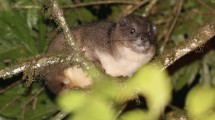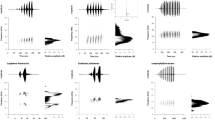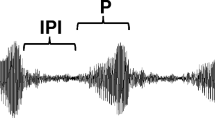Abstract
A rain forest dusk chorus consists of a large number of individuals of acoustically communicating species signaling at the same time. How different species achieve effective intra-specific communication in this complex and noisy acoustic environment is not well understood. In this study we examined acoustic masking interference in an assemblage of rain forest crickets and katydids. We used signal structures and spacing of signalers to estimate temporal, spectral and active space overlap between species. We then examined these overlaps for evidence of strategies of masking avoidance in the assemblage: we asked whether species whose signals have high temporal or spectral overlap avoid calling together. Whereas we found evidence that species with high temporal overlap may avoid calling together, there was no relation between spectral overlap and calling activity. There was also no correlation between the spectral and temporal overlaps of the signals of different species. In addition, we found little evidence that species calling in the understorey actively use spacing to minimize acoustic overlap. Increasing call intensity and tuning receivers however emerged as powerful strategies to minimize acoustic overlap. Effective acoustic overlaps were on average close to zero for most individuals in natural, multispecies choruses, even in the absence of behavioral avoidance mechanisms such as inhibition of calling or active spacing. Thus, call temporal structure, intensity and frequency together provide sufficient parameter space for several species to call together yet communicate effectively with little interference in the apparent cacophony of a rain forest dusk chorus.




Similar content being viewed by others
References
Amézquitas A, Flechas SV, Lima AP, Gasser H, Hödl W (2011) Acoustic interference and recognition space within a complex assemblage of dendrobatid frogs. Proc Natl Acad Sci USA 108:17058–17063
Bee A, Micheyl C (2008) The cocktail party problem: What is it? How can it be solved? And why should animal behaviorists study it? J Comp Psychol 122:235–251
Brumm H (2006) Signalling through acoustic windows: nightingales avoid interspecific competition by short-term adjustment of song timing. J Comp Physiol A 192:1279–1285
Brumm H, Slabbekoorn H (2005) Acoustic communication in noise. Adv Stud Behav 35:151–209
Capranica RR, Moffat AJM (1983) Neurobehavioral correlates of sound communication in anurans. In: Ewert JP, Capranica RR, Ingle D (eds) Advances in vertebrate neuroethology. Plenum, New York, pp 701–730
Chek AA, Bogart JP, Lougheed SC (2003) Mating signal partitioning in multi-species assemblages: a null model test using frogs. Ecol Lett 6:235–247
Crawley MJ (2007) The R book. Wiley, Chichester
Darwin C (1988 reprinted) The voyage of the Beagle. NAL Penguin, New York, p 10
Diwakar S, Balakrishnan R (2006) The assemblage of acoustically communicating crickets of a tropical evergreen forest in southern India: call diversity and diel calling patterns. Bioacoustics 16:113–135
Diwakar S, Balakrishnan R (2007) Vertical stratification in an acoustically communicating ensiferan assemblage of a tropical evergreen forest in southern India. J Trop Ecol 23:479–486
Diwakar S, Jain M, Balakrishnan R (2007) Psychoacoustic sampling as a reliable non-invasive method to monitor orthopteran species diversity in tropical forests. Biodivers Conserv 16:4081–4093
Farris HE, Forrest TG, Hoy RR (1997) The effects of calling song spacing and intensity on the attraction of flying crickets (Orthoptera: Gryllidae: Nemobiinae). J Insect Behav 10:639–653
Ficken RW, Ficken MS, Hailman JP (1974) Temporal pattern shifts to avoid acoustic interference in singing birds. Science 183:762–763
Forrest TG, Green DM (1991) Sexual selection and female choice in mole crickets (Scapteriscus: Gryllotalpidae): modeling the effects of intensity and male spacing. Bioacoustics 3:93–109
Gerhardt HC, Huber F (2002) Acoustic communication in insects and anurans: common problems and diverse solutions. University of Chicago Press, Chicago
Gogala M, Riede K (1995) Time sharing of song activity by cicadas in Temengor Forest Reserve, Hulu Perak, and in Sabah, Malaysia. Malay Nat J 48:297–305
Greenfield MD (1988) Interspecific acoustic interactions among katydids Neoconocephalus: Inhibition-induced shifts in diel periodicity. Anim Behav 36:684–695
Hummel J, Kössl M, Nowotny M (2011) Sound-induced tympanal membrane motion in bushcrickets and its relationship to sensory input. J Exp Biol 214:3596–3604
Jain M, Balakrishnan R (2011) Microhabitat selection in an assemblage of crickets (Orthoptera: Ensifera) of a tropical evergreen forest in Southern India. Insect Conserv Div 4:152–158
Jain M, Balakrishnan R (2012) Does acoustic adaptation drive vertical stratification? A test in a tropical cricket assemblage. Behav Ecol 23:343–354
Jain M, Kuriakose G, Balakrishnan R (2010) Evaluation of methods to estimate foliage density in the understorey of a tropical evergreen forest. Curr Sci 98:508–515
Kostarakos K, Hartbauer M, Römer H (2008) Matched filters, mate choice and the evolution of sexually selected traits. PLoS ONE 3:e3005
Langemann U, Klump GM (2005) Perception and acoustic communication networks. In: McGregor PK (ed) Animal communication networks. Cambridge University Press, Cambridge, UK, pp 451–480
Luther D (2009) The influence of the acoustic community on songs of birds in a neotropical rain forest. Behav Ecol 20:864–871
McCullagh P, Nelder J (1989) Generalized linear models. Chapman & Hall, Boca Raton
Nityananda V, Balakrishnan R (2006) A diversity of songs among morphologically indistinguishable katydids of the genus Mecopoda (Orthoptera: Tettigoniidae) from Southern India. Bioacoustics 15:223–250
Planqué R, Slabbekoorn H (2008) Spectral overlap in songs and temporal avoidance in a Peruvian bird assemblage. Ethology 114:262–271
Popp JW, Ficken RW, Reinartz JA (1985) Short-term temporal avoidance of interspecific acoustic interference among forest birds. Auk 102:744–748
Römer H (1998) The sensory ecology of acoustic communication in insects. In: Hoy RR, Popper AN, Fay RR (eds) Comparative hearing: insects. Springer, New York, pp 63–96
Römer H, Bailey W, Dadour I (1989) Insect hearing in the field. III. Masking by noise. J Comp Physiol A164:609–620
Ryan MJ, Keddy-Hector A (1992) Directional patterns of female mate choice and the role of sensory biases. Am Nat 139:S4–S35
Schmidt AKD, Römer H (2011) Solutions to the cocktail party problem in insects: selective filters, spatial release from masking and gain control in tropical crickets. PLoS ONE 6:e28593
Schmidt AKD, Riede K, Römer H (2011) High background noise shapes selective auditory filters in a tropical cricket. J Exp Biol 214:1754–1762
Schmidt AKD, Römer H, Riede K (2013) Spectral niche segregation and community organization in a tropical cricket assemblage. Behav Ecol 24:470–480
Sueur J (2002) Cicada acoustic communication: potential sound partitioning in a multispecies community from Mexico (Hemiptera: Cicadomorpha: Cicadidae). Biol J Linn Soc 75:379–394
Venables WN, Ripley BD (2002) Modern applied statistics with S. Springer, New York
Wehner R (1989) “Matched filters”—neural models of the external world. J Comp Physiol A 161:511–531
Wollerman L, Wiley H (2002) Possibilities for error during communication by neotropical frogs in a complex acoustic environment. Behav Ecol Sociobiol 52:465–473
Wong S, Parada H, Narins PM (2009) Heterospecific acoustic interference: effects on calling in the frog Oophaga pumilio in Nicaragua. Biotropica 41:74–80
Acknowledgments
We thank the Ministry of Environment and Forests, Government of India for funding and the Karnataka State Forest Department for permits. RD is supported by CSIR, India. Many thanks to Vivek Nityananda, Natasha Mhatre and Chandra Sekhar Seelamantula for help with computer codes, Hastagiri Prakash for suggestions on the algorithm for simulation for pairwise ASO and to Sudhakar Gowda and Hanumanthan Raghuram for help with fieldwork. We thank two anonymous referees and the Associate Editor for suggestions that greatly improved the manuscript. Author contributions: MJ carried out the work on ASO, SD on ETO, JB on EAO in natural choruses, RD statistical analyses and figures, RB designed the study, RB and MJ wrote the manuscript. Data and codes are available from the authors. This article is dedicated to Otto von Helversen.
Author information
Authors and Affiliations
Corresponding author
Electronic supplementary material
Below is the link to the electronic supplementary material.
Rights and permissions
About this article
Cite this article
Jain, M., Diwakar, S., Bahuleyan, J. et al. A rain forest dusk chorus: cacophony or sounds of silence?. Evol Ecol 28, 1–22 (2014). https://doi.org/10.1007/s10682-013-9658-7
Received:
Accepted:
Published:
Issue Date:
DOI: https://doi.org/10.1007/s10682-013-9658-7




